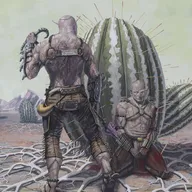The spider cactus sits unmoving until a victim
or victims are within range. Anyone that moves within 15’
of this deadly cactus is subject to attacks from its tethered
projectile needles. Spider cacti can sense living creatures
and anything with liquid.
The spider cactus has 5-8 sets of barbed purple
projectile needles and 3-18 larger green feeding needles. It
always attacks with a set of 8 purple needles. They attack
only one victim at a time. It takes three mintes to pull
strands which miss back in and a full day before they can
fire again. If some of the strands are severed, it does not
use that set again until all eight are restored. Damaged
needles regrow at the rate of three per week.
In combat, the cactus first fires a set of purple needles,
attempting to capture a victim. The victim is then dragged
to the body and impaled on the feeding needles. The
cactus feeds until it has drained all available liquid from
the victim, and then releases the husk. Each cactus in
range attacks with its purple projectile needles which can
cause paralysis.
The spider cacti are competitive - if one victim is in
range of several cacti, it is fought over by all of them.
If one victim is snared by several cacti, the cactus with
the most needles in him is the one that finally gets him.
However, the other cacti pull as long as they can until
their needles finally rip out.
Terrain: Tablelands
Frequency: Uncommon
# Appearing: 2-8
Spider cactus patches look like any patch of harmless
cacti until a victim is showered by their needles. The
victim is then dragged into the cactus, where the feeding
needles make a slow feast of the hapless being.
The spider cactus has a barrel-shaped body, 2 to 3
feet across, and from 6 to 7 feet tall. It is bright green in
color, with streaks of white along the barrel. The needles
are purple and green.

